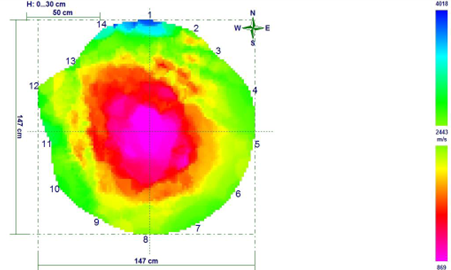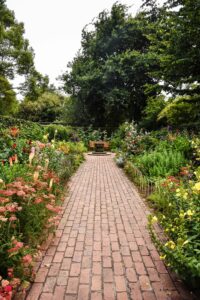Technology plays an increasingly important role in almost every business although you may be forgiven for thinking that when working with trees and gardens we have limited use of gadgets; however, this is not the case.
For several years we have used sonic tomography for tree risk assessments to find out the extent of decay and damage in living trees.

A Recent case study
As an example, during a recent visual tree assessment of an oak tree we identified the presence of several cavities within the crown break area of the main branch scaffold.
This was immediately followed by an internal investigation using an Arbotom (Sonic Tomography), in order to assess the extent of decay within the trunk. We then used a Resistograph (Micro-drill) to ascertain the size of the cavity and the structural integrity of the surrounding woody tissue.
The tree was overhanging a garden/ car parking area and significantly overhung the neighbouring properties front garden and driveway.
Decay within trees can be a major concern in relation to human safety and damage to property. It can eventually weaken stems, branches, or roots enough to increase the chance of mechanical failure. Strength loss of a tree trunk or branch is dependent upon the extent and the location of decay.
Decay is also a natural process and commonly occurs within trees without causing structural weakness. It is therefore not always appropriate to regard a tree as hazardous merely because decay has been identified.
The evaluation of the extent of decay within a tree can provide informed management decisions. With tree height being the most important factor dominating the tree base bending movement due to wind loading of mature trees.
This will ensure hazardous trees are correctly identified and relatively safe trees are not removed or unsuitably pruned.
Originally this tree was part of a field hedgerow system and was retained when the estate was built. It has therefore grown in an open situation which has led to its development as a fairly squat, wide canopied tree. It has developed a multi-stemmed crown break at 3.5m rather than growing with a single central leader.
The results of the sonic tomograms indicated that there was a column of decay within the centre of the tree emanating from the roots/ground level and travelling through the trunk to a point in the crown break. It did not appear to have merged with the cavities as yet, but it is just a matter of time as there was already some soft tissue penetration within them.
The Ganoderma bracket present within the crown break is a heart rot fungus usually present on damaged wood. It puts on layers annually and had about 20 so far, indicating that it, and the associated decay, has been present for some time and was probably linked to the column of decay.


All evidence indicated that the structural integrity and stability of the tree had been compromised in the area of the crown break.
This was due to the presence of the decay column which merged with the decay associated with the Ganoderma, and the large cavities at the base of the branch scaffold just above the crown break, resulting in an area of weakness.
The Resistograph readings confirmed that Cavity B, below the branch tear-out, had a residual wall thickness of approximately 170mm and a cavity of approximately 450mm diameter. With this information at hand we were able to carry out a balanced and phased sympathetic crown reduction of 3- 4m resulting in the overall height of the tree being reduced to approximately 13m.
By reducing the overall size and weight of the crown, we were able to reduce stresses in the crown break and the associated nearby cavities to maintain structural integrity, health, and longevity.
There is now a regular visual inspection programme in place, carried out every 15 months to monitor the condition of the tree and repeat internal investigation (Arbotom) carried out in three years’ time.
If you have any concerns over the trees on your property and would like expert advice, or require a tree safety survey, please contact us.
For more information about tree management contact us at [email protected].









